Article
The Hospice of Beaune: 450 Years of Service to the Poor
Author(s):
The Hospice of Beaune saw its first patient on January 1, 1452, and its last in 1971. The secret to its success? A salt mine and a winery.
Photography by the author
One of the oldest hospitals in France was built in Beaune in Burgundy. It was erected in 1443 to serve the poor at a time when Europe, devastated by the 100 Years’ War, suffered great hardships.
There was no order in the land especially in Burgundy. Marauding bands roved the countryside pillaging and destroying villages. The country people abandoned their fields and sought refuge in the walled cities. Crops failed. People starved. Disease was rampant.
The ruling Duke of Burgundy, Philip the Good, despaired. “He was called ‘the Good,’” a guide once sniffed at us in Dijon, “because he was good with the ladies. He had 15 illegitimate children.”
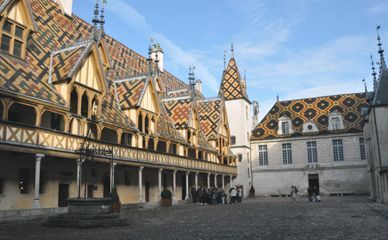
But he was good also at delegating. He had a most conscientious and capable chancellor called Nicolas Rolin who, with his wife Guigone de Salins, was horrified at the poverty they found around them. They decided to start a hospital for the poor in Beaune. They surely could afford to do this. The Duke was no fool: he had made his chancellor rich.
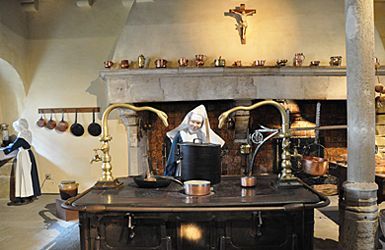
Rolin discovered many of the local people were ill because they were starving. He built the hospital with a huge kitchen and spent money to do things right, endowing it with a salt mine and a vineyard to give it income. Indeed he created a model hospital for his time. It saw its first patient on January 1 in 1452 and had patients until 1971 when its medical activities were transferred to a modern facility.
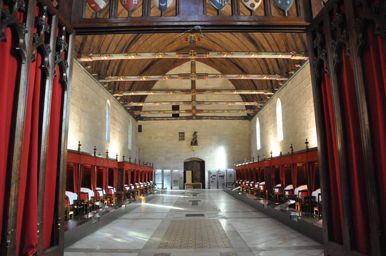
The ceiling is oak paneled and crafted like a ship’s hull. The cross beams are held in the mouth of carved dragons. The tiles on the floor reveal the word Seule (“Only”) showing Guigone was the only one in her husband’s thoughts. Patients were well fed from pewter dishes, not the wooden bowls of the times. They had a comfortable dormitory although they slept two to a bed. A chest behind the beds kept their clothing.

The Chapel was an integral part of this Hall of the Poor where the patients slept. “It shows the perfect alliance of the religious and medical services of the time,” says our guide. “Patients could take part in services without moving around or getting out of bed.” Rooms were also created where benefactors could indulge their wishes to do good work.
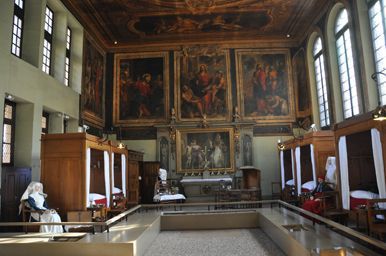
The St. Hugues Room, for example, had expensive paintings some showing St. Hugues bringing two children who had died in the plague back to life. Wealthy people (‘noble souls”) could be treated in the hospital, too, and often left substantial donations to the hospital when they died. Many productive vineyards were bequeathed to the hospital which surely helped its expansion.
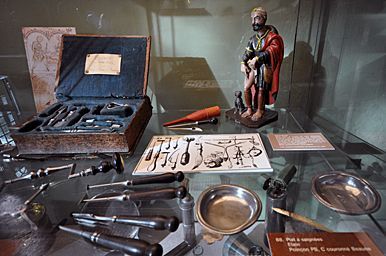
Our readers who are Californian hospital administrators might be salivating at the thought of having a benefactor donate a winery to their hospital, but physicians might also be interested in the pharmacy and the room that has a collection of medieval surgical instruments.
The St. Louis Room—that now contains 16th century tapestries including seven telling the story of the Prodigal Son–originally was a bakery and wine fermenting room. Visitors studying the tapestries were already talking about the next attraction, a 15th century polyptych, a multi-paneled painting of the Last Judgment waiting in its special presentation in the room beyond. Painted by the Flemish artist Rogier van der Weyden in 1448-1451 it was previously placed above the altar in the chapel before the hospice became a museum.
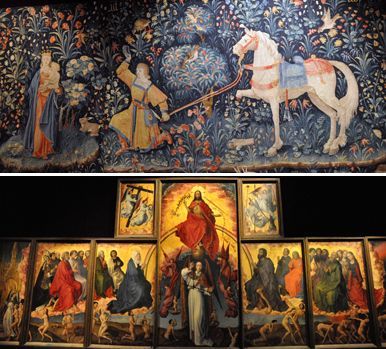
The Hospice de Beaune now has 400,000 visitors a year. Not only are its wines famous, earning about 4 million Euros a year, but its celebrated annual wine auction continues to fund its many of its local charitie.
Eric Anderson, Physician's Money Digest's resident travel & cruise columnist, is a retired MD and former president of the NH Academy of Family Practice, and now lives in San Diego. The only physician in the American Society of Travel Writers, he has also written five books, the last called The Man Who Cried Orange: Stories from a Doctor's Life.




